Content
Rose bushes planted on the site transform it, making it cozy and beautiful. Most varieties and species are distinguished by the splendor of flowering and unpretentious care. The climbing rose Eva is no exception, which takes up little space and can be used even for the smallest areas.
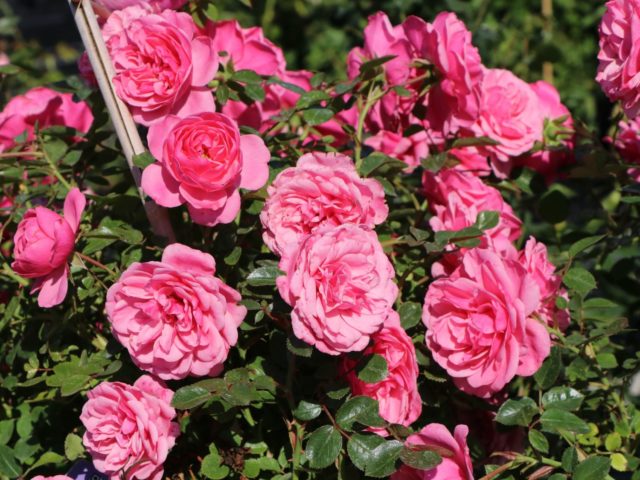
Variety "Eva" blooms throughout the summer
Breeding history
Climbing rose "Eva" (Eva) - the result of the work of German breeders from the company "Rosen Tantau", located in the north of Germany. She is renowned for her achievements in the cultivation of new cut varieties for planting in greenhouses and open field. The company began its work more than a century ago, and during this time has acquired a significant prestige among specialists and amateur gardeners.
Rose of the "Eva" variety, belonging to the "Starlet" series, was bred in 2013. Miniclimber is distinguished by high quality seedlings, long flowering, the ability to use it in the design of the site, veranda and balcony.
Description and characteristics of the climbing rose Eva
Since the park rose "Eva" belongs to the mini-limers, its shoots do not grow more than 1.5-2.2 m. Due to their elasticity, they can do without support, but for greater reliability it is worth organizing it for a climbing rose, and, if necessary, tie it up ... The bush is dense, powerful, constantly forming basal shoots and ramifications, grows up to 1 m wide.
The pink flowers are large (6 cm in diameter), double, pompom-like, collected in large inflorescences. The petals are wavy, in the shape of a cup. After full blooming, the buds stay on the shoots for a long time. Their aroma is not strong, pleasant, sweetish.
The young foliage of the plant has a reddish tint, later it becomes a dark green, dense structure.
Variety "Eva" refers to frost-resistant, but with the onset of winter, the branches must be removed from the support and covered. Experts note the weak susceptibility of the climbing rose Eva to diseases and pests, subject to the rules of agricultural technology and proper care.
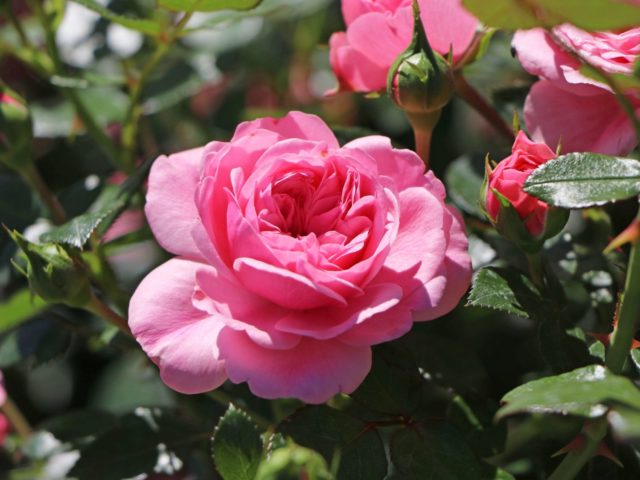
Before planting, the cut of the stem of the rose "Eva" is treated with a solution of 96% ethyl alcohol
Advantages and disadvantages of the variety
The climbing "Eva" has a number of advantages over other varieties:
- high survival rate of seedlings;
- resistance to adverse weather;
- early, long, multiple flowering;
- developed immunity to diseases and pests;
- average winter hardiness (6 climatic zone);
- self-cleaning buds;
- pleasant aroma.
There are few disadvantages of the climbing rose "Eva":
- the need for shelter for the winter;
- strong burning of petals in the sun.
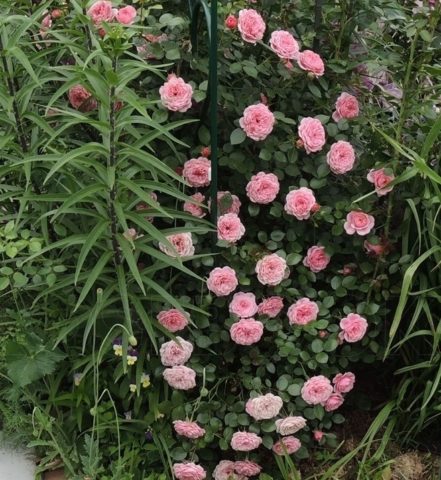
Summer pruning of faded shoots - a means of regulating the flowering of a rose
Reproduction methods
The most effective way to propagate the climbing rose "Eva" is cuttings. The method is distinguished by its simplicity of execution and a high percentage of rooting.
Cuttings containing at least two internodes are cut from healthy shoots after the first wave of flowering. Their length is about 10-15 cm, the lower cut is made oblique, the upper one is straight.
Rooting can be carried out in water or in a special substrate consisting of sand and ordinary earth.In the first case, the leaf plates are shortened by 2/3 and the cuttings are lowered into water with the addition of a growth stimulator. After a month and a half, roots appear on them, after which the climbing rose seedlings are transferred to open ground.
When placing the planting material in the substrate, make sure that the embedding depth is no more than 1 cm. Top cuttings are covered with glass or plastic containers and shaded. It is necessary to monitor the humidity, periodically ventilating the shelter.
It is allowed to inoculate a climbing rose "Eva" with a sleeping eye on a two-year-old rosehip (in the root collar). This method requires certain skills, the percentage of kidney survival is very low.
Planting and caring for a climbing rose Eva
When choosing a place for a seedling, it is necessary to take into account that the climbing rose "Eva" grows well and develops in an area protected from drafts and northern winds. The place should be sufficiently lit in the evening and morning, and have a little shade at noon.
It is unacceptable to place the seedling of the climbing rose "Eva" in low-lying places, where there is stagnation of water in the soil and cold air at night. After choosing a place, you need to plant the plants correctly and take care of them thoroughly.
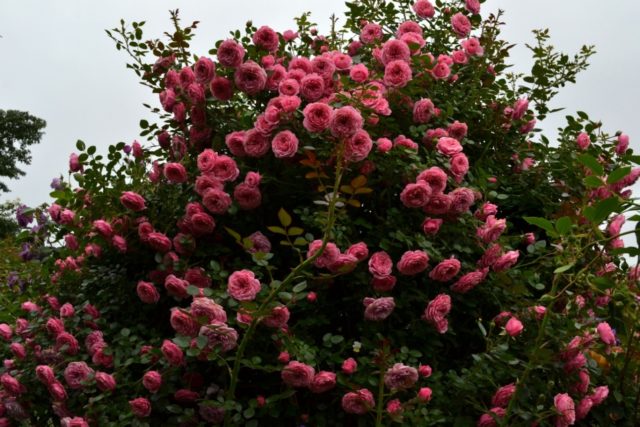
When the first signs of powdery mildew appear, it is necessary to remove the affected foliage
Landing
The planting of the climbing rose "Eva" begins in late April or early May. For her, a pit 60 cm deep is prepared, drainage, compost and garden soil are laid on the bottom. The root system is dipped into the stimulant solution and after 1 hour the plant is planted, placing it at an angle of 30⁰ with respect to the support. Watered at the root, add soil to the pit if it has settled and mulched with peat.
Watering and feeding
Despite the drought resistance of the climbing rose "Eva", moistening the soil under it is a mandatory procedure in dry periods. Average consumption should be 15 liters per bush. Watering is carried out with warm settled water in the morning or evening hours.
Top dressing is carried out several times per season: in the spring - with nitrogen fertilizers, in the summer - with potassium-phosphorus fertilizers.
Pruning
The procedure is carried out with the aim of forming a bush, rejuvenating it or sanitizing a plant.
In the spring, the shoots are shortened to four buds so that the plant takes root faster after planting, blooms profusely and looks healthy. Autumn pruning for sanitary purposes involves removing old, diseased and damaged shoots.
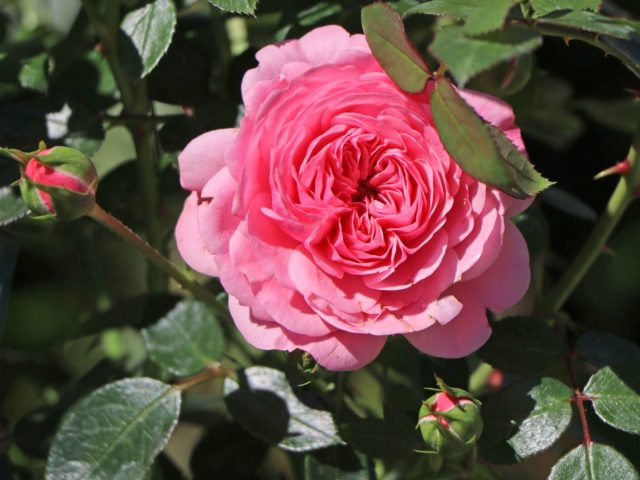
When planting flowers along the paths, a distance of 1 m is left between the bushes
Preparing for winter
With a decrease in temperatures below -7 уюС, the climbing rose "Eva" is covered. First, the shoots are shortened, and the base of the bush is spud up high, then the branches are laid horizontally and covered with spruce branches, a rigid frame is installed on which non-woven material and film are pulled.
Pests and diseases
The defeat of the climbing rose "Eve" with fungal diseases leads to the loss of its decorative effect, and sometimes to death. The causes of the disease are most often unfavorable weather conditions, violation of agricultural techniques or improper care.
Coniotirium
Among the main symptoms of a fungal disease are red, burn-like spots on the bark, which gradually turn black and cover the shoot around the circumference. When they appear, it is necessary to cut out the affected parts of the plant and burn it.
Bacterial cancer
The disease manifests itself in the form of growths, at first soft, and then hardening to the state of a stone. Bacterial cancer cannot be treated, the entire affected plant is removed from the site and disposed of.
Powdery mildew
The main sign of powdery mildew is white bloom, which gradually takes on brown shades.To combat the disease, copper sulfate preparations are used, spraying is carried out in several stages.
The main pests that can damage the climbing rose "Eve" are aphids and spider mites. For their destruction, both folk remedies (soap solution, infusion of tobacco or wormwood) and chemical preparations (insecticides and acaricides) are used.
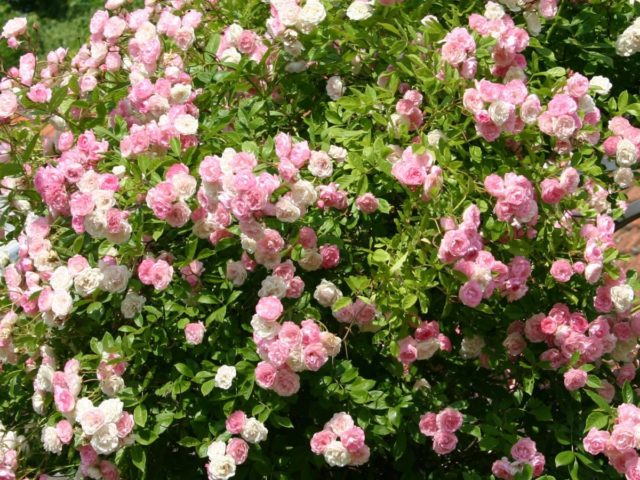
Rose "Eva" can be grown as a container plant
Application in landscape design
The abundance of flowers of the climbing rose "Eva", their delicate pink color and decorativeness make it possible to use the mini-lighter in various types of landscape design. Both single and group landings are successfully used.
Hedge
If there are unattractive buildings on the site, they can be disguised with a hedge made of climbing roses "Eva". Pulling a grid for it or installing a lattice, several tasks for the design of the territory are solved at once - a bright accent is created and the site is divided into zones.
Arches
Despite the small length of the shoots of the climbing rose "Eva" (about 2 m), it is not difficult to arrange an arch with their help. It is installed at the entrance or used as a decorative element anywhere on the site. In order for the shoots to hold well, they must be carefully wrapped around the arched elements. It is possible to use a climbing rose of the "Eva" variety together with other vines - lemongrass, clematis.
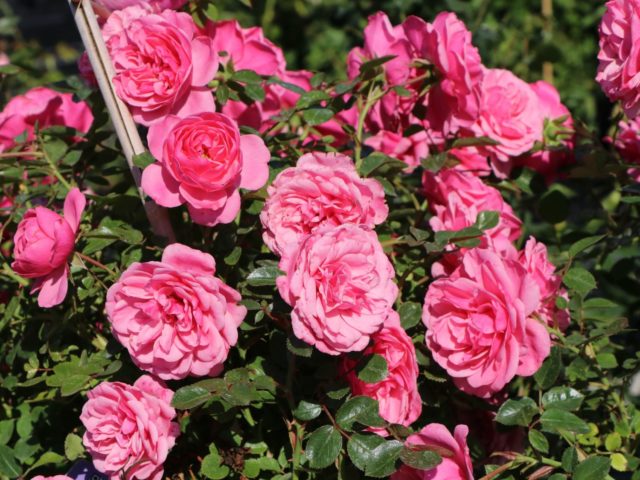
A rose cluster can have more than 10 buds per inflorescence
Rose garden
From mini-lights, you can create a small garden where the shoots are located vertically, resting on trees, columns or pillars. Climbing roses "Eva" look interesting in combination with other varieties or undersized flowers.
Tapeworms
Climbing rose "Eva" as a tapeworm looks spectacular on the lawn, next to large boulders or stones, against the background of conifers or ornamental shrubs. In this case, reliable support is required. In its absence, the plant can be used as a ground cover.
Terrace or balcony design
The design of the entrance to the terrace, gazebo or pergola, made with the climbing rose "Eva", allows you to give them comfort. It is permissible to plant a plant in a container on the balcony. The main thing is that it is not under the bright sun all daylight hours.
Conclusion
Climbing rose Eva is a great option for decorating a garden that occupies a small area. Subject to the rules of agricultural technology, it is able to ennoble even the most unattractive piece of land, decorate its unsightly elements and create a mood, thanks to a long and abundant flowering.
Reviews of climbing tea-hybrid rose Eva








